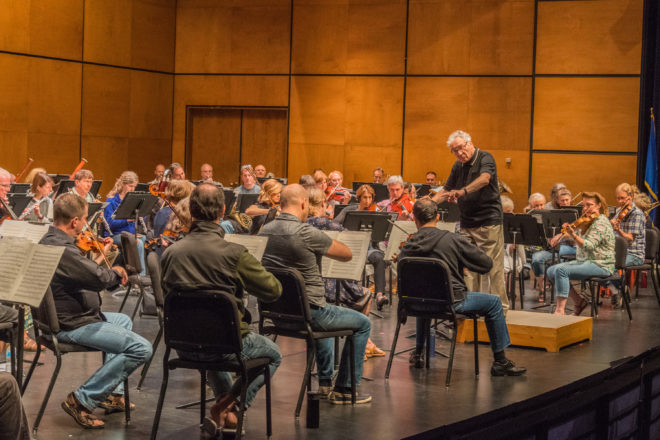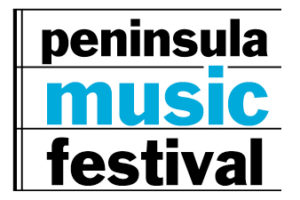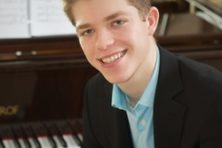Aureole: An Interview with Composer Augusta ‘Gusty’ Read Thomas
- Share
- Tweet
- Pin
- Share

You might want to bring your solar eclipse shades to the final concert in the 65th season of the Peninsula Music Festival (PMF), for it begins with the absolutely radiant Aureole by Augusta “Gusty” Read Thomas.
PMF Music Director Victor Yampolsky chose Aureole for the final concert of the season because of its proximity to the Aug. 21 solar eclipse.
“Her music attempts to ‘translate’ our visual experiences of overwhelming brightness and cosmic storms of the sunlight into aural experience of orchestral colors and rhythms, which she achieves with remarkable mastery and originality of composition,” Yampolsky told the Pulse.
The barely eight-minute piece was commissioned by DePaul University School of Music to celebrate its centennial school year in 2012-13, and was conceived to precede a performance of Beethoven’s Symphony No. 9.
Aureole opens with a shimmering fanfare in D, of violins, triangles and brass. A sense of heat, light and brute power radiate from the orchestra’s circular undulations. Percussive elements – the aforementioned triangles as well as high bongos, congas, low tom-toms, resonant wood blocks, claves, vibraphone, Taiko drums (or low tympani) and a glockenspiel – erupt like solar flares from that shimmering musical surface.
“Pure protein” is how Thomas described the piece in a recent telephone conversation.
“With Aureole, there were several things,” she said. “One has to do with resonance because in a way I’m composing into the orchestra a kind of resonance. I’m taking care of the middle of the note and the end of the note. It’s not just all attack there, but a real sense of flow in a way in terms of the momentum and harmonic rhythm. There is also just a certain brute brilliance or vibrancy or sunshine. I don’t know what the word is, but there is a real energy force if you zoom out from the piece. It’s a series of organized outgrowths. You start out with this sort of fanfare opening and that continues to iterate into a high energy. The cloud melts into another cloud. It’s still a cloud, but you’re seeing it from a different perspective.”
This all makes perfect sense if you know the piece.
“Everything matters, and everything is part of the argument. And it lasts 7½ minutes,” she said. “One of the things that interests me about music and composing my own music, the idea of saying an enormous amount in 7½ minutes. There’s a lot of information per square inch. There’s no fluff. There is a sense of all of these little transformations are part of this bigger picture.”
And where in the traditionally epic world of classical composing does she trace the roots of the short story form?
“I think my big model is Johann Sebastian Bach, who I listen to every day of my life,” she said. “He can say an enormous amount in two-minute prelude or a one-minute Goldberg Variation. Or a three-minute movement, say from one of the Partitas. It’s incredibly action packed, very spiritual, deeply, profoundly gorgeous, rich. Little gems that Bach is making and he doesn’t need to go on. That’s what the material called for. So that is what I am thinking of – what material have I built to make the piece and then to use that material in a way that people can find a niche and hear that piece and there it is, but also that it is rich so that if you come back to the piece you hear other layers and connections and other long-term colors, either harmonic or contrapuntal, whatever it might be.”
Listening closely to Aureole and other works by Thomas, you can’t help hearing things that make you think she might also be a jazz fan.
“Yes, indeed. Absolutely. Thank you for listening,” she said, adding that she played trumpet through college in the jazz band.
“In terms of the big picture, if we zoom out, I want my music to be highly nuanced,” she said. “Every note has an articulation, a dynamic, usually an adjective, very, very detailed as to what kind of sound I want, and at the same time I want it to have this spontaneity in the way that a jazz musician is going for the note (and she scats a jazz line as an example of what she means). Going for the next note. You can hear it in their stomach that they are reaching up for that high note. I want to capture all of that aliveness and that inner life and sense of almost like little emergencies imbued with a sense of life. So I try to capture that in my music, capture it in a notation where people can read it and capture that spontaneity, and that’s a tricky balance, to notate it and keep that inner life going. I feel like that sense of spontaneity and caprice, whim, life force whatever you want to call it, is all over my music, and I know it’s coming from listening to jazz.”
PMF Executive Director Sharon Grutzmacher said it’s a pretty big deal not only to perform this work but to have the composer in attendance for the performance, as Thomas will be. It will be her first visit to Door County.
“I look forward to meeting the audience and being present and being part of it. That will really be a thrill for me. I know the orchestra is great. The whole thing is a really good fit,” she said. “I’m very comfortable in those settings. I was composer in residence for the Chicago Symphony for many, many years, 1996-2007, I did about 50 pre-concert lectures each year and spoke from the stage a lot…for every new piece. I’m very comfortable in those settings. I enjoy meeting the audience and hearing what they felt or thought.”
Along with Aureole, this final concert of the 65th PMF season includes another first performance – Prokofiev’s Symphony No. 7, Op. 131 in C-sharp minor. They will also perform Shostakovich’s Violin Concerto, Op. 77 in A minor, with violinist James Ehnes.
For more on Peninsula Music Festival’s 65th season, visit musicfestival.com.
Thomas Recognized for Ear Taxi Fest
Last year the Chicago Tribune recognized composer Augusta “Gusty” Read Thomas as Chicagoan of the Year in classical music for putting together the Ear Taxi Festival, featuring 500 Chicago musicians and 56 world premieres.
The newspaper cited her ability to make everybody want to work together – “Not an attitude one associates with the once-balkanized Chicago new-music turf,” reporter John von Rhein wrote at the time.
“I think the festival really showed off the sense of collaboration we enjoy in Chicago,” Thomas said. “It was massive, basically six solid days of music.”
However, she adds, “It almost killed me. It took three years to put it all together. It was so much work, the whole thing out of my living room. I could never, ever do it again, unless there was a staff.”
While she said it will probably remain a one-off event, she does believe the festival had a ripple effect for most involved.
“If somebody took an interest and went on to commission new music, or even learned that you could commission a composer to compose for your partner, your wife, your mother’s birthday, something like that,” Thomas said.
On top of that, every group that performed was given the names of the people who attended their performance, and 6,000 people attended throughout the week.
“We sent them all of that rich data, and that for them is golden,” Thomas said. “I think it really brought awareness. There were banners on street poles. It brought a lot of awareness to new music in general.”





